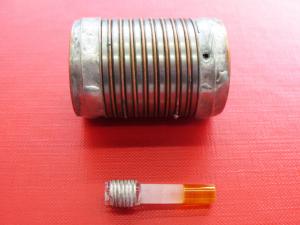CERN's swift action allows Japan to proceed
22 Jul 2011
-
Luca Bottura and Bernardo Bordini, CERN TE/MSC
Two of the samples prepared and tested within the scope of the verification measurements: A wire is mounted and soldered on the TiAlV sample holder ready for critical current testing (background), and a miniature coil used for the magnetization of the superconductor magnetization and associated hysteresis loss (foreground).
A mandatory step in the manufacturing process of the superconducting wires for the ITER magnets is the measurement of the wire performance at each of the suppliers. This quality control step is complemented by an independent verification measurement performed by the Domestic Agency responsible for the supplier.
This strict acceptance procedure guarantees that the tight performance specifications of the ITER cables are met. Once the compliance with the specification is verified, the Domestic Agency clears the billet Authorization to Proceed Points (ATPPs) authorizing the fabrication of the superconducting cable, the next phase in the ITER magnet production. It is of obvious importance that the Quality Assurance measurements follow a tight schedule, avoiding delays in the magnet manufacturing.
This process was disrupted by the earthquake that hit Japan in March 2011, and dramatically affected operation at the Japanese Domestic Agency. The ITER Organization took swift action to assist the Japanese Domestic Agency by drawing on the capacity present at the ITER Organization Reference and Training Laboratory, a fruit of the CERN-ITER collaboration formed in July 2009.
Support came in the form of verification measurements on 12 billets of Nb3Sn bronze route strand for the ITER toroidal field magnets, recently produced by one of the Japanese suppliers. The verification measurements consist in critical current, hysteresis loss and residual resistivity ratio measurements of samples coming from each billet. Typical samples for these measurements are shown in the picture.
These measurements were carried out with the highest priority at CERN since the time available was quite short. The wire lengths for the samples preparation arrived at CERN on 23 May. About three weeks were necessary for the heat treatment of the material to form the superconducting phase, and the measurement results had to be released by 15 July.
Measurements started on 16 June, and the last sample was tested on 13 July. Preliminary data was released during the measurement process, to provide early feed-back on results, and the analyzed data was finally sent to the ITER Organization on 15 July, just making the deadline. All the samples satisfied the ITER specifications and now the Japanese Domestic Agency can proceed in time with the next production step.


